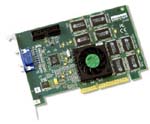The Monster Fusion
Diamond's Monster Fusion differentiates itself from the pack in a number of ways. Simply by looking at the card, you'll notice the high quality heatsink and fan. While the vast majority of Banshee products feature SDRAM, the Fusion has 8ns/125MHz SGRAM on board. Diamond has taken advantage of both these items to clock their boards at 115MHz core clock and 125MHz memory clock - well beyond the official 3dfx specification of 100MHz core and 110MHz memory clocks. Thanks to these clock speed increases, the Monster Fusion features a theoretical fill rate 15% higher than other Banshee boards. This of course translates to the Monster Fusion being the fastest Banshee on the market - without the need to overclock and, thus, risk voiding the warranty.
Diamond did not skimp on the software side of things either. Bundled in the box are a special version of Unreal featuring 11 levels, a full version of Motocross Madness, and Zoran SoftDVD. The Banshee features little DVD acceleration in hardware, so it has to rely completely on the software, and hence the CPU, for DVD playback.
Integrated into the drivers is Diamond's In Control Tools 98, which provide a number of potentially useful features. There are of course some mostly standard tweaking options for 3D, such as toggling vsync and gamma correction. Thank 3dfx and Diamond for the ability to control 3D gamma correction separately from desktop gamma correction.
Of course, simply being based on the Banshee has its own set of advantages. First off is the Glide compatibility. While this is becoming less and less important, there are still some games that run best on Glide (Unreal still doesn't have a good Direct3D or OpenGL driver, although it should shortly). The integrated 250MHz RAMDAC does a pretty good job of 2D output - the quality is definitely above that of the TNT and Savage3D cards, but not quite to the level of the Matrox G200. Don't forget, as an AGP solution in name only, the Banshee has no compatibility problems with the Super7 platform. In fact, the latest driver set features pretty good 3DNow! optimization.
On the flip side, there are some disadvantages to the Banshee. Being based on the Voodoo2 core, which is an older chipset, means that image quality suffers compared to the latest crop of cards due to the lack of support for 32-bit rendering. The Banshee also only features one texture unit, meaning that performance will suffer in games that use multiple rendering passes. Finally, the Banshee (and all other 3dfx cards for that matter) lacks a true OpenGL ICD and substitute a miniGL driver for Quake 1/2 engine support.











1 Comments
View All Comments